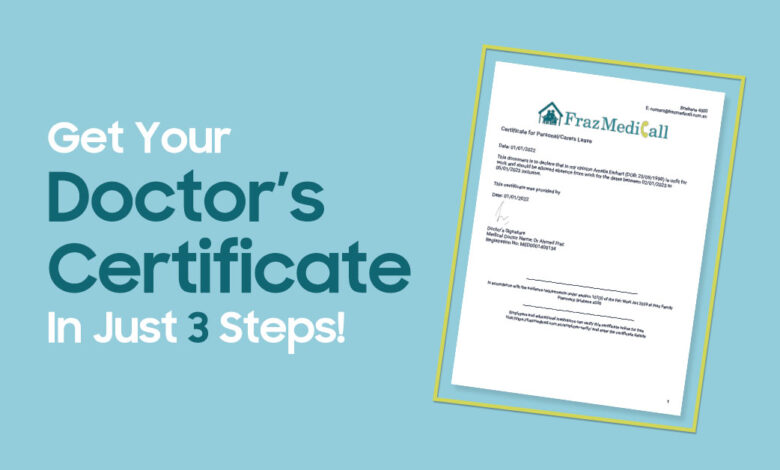Medical Certificates in Australia: Everything You Need to Know

Medical certificates have become an essential document in Australia, especially in the current times, where the pandemic has affected us all in one way or the other. Whether it is due to illness, injury, or other health conditions, sometimes employees require time off work. In such situations, medical certificates come in handy, certifying that a person is unwell and needs rest. In this blog post, we’ll take you through everything you need to know about medical certificates in Australia, including what they are, what they include, and the laws and regulations surrounding them.
What is a medical certificate?
A medical certificate is a legal document issued by a registered health practitioner, such as a doctor or a specialist, certifying that a person is ill or injured and can’t attend work. The certificate typically includes the patient’s name, the nature of the illness or injury, the date and time of the examination, the expected duration of incapacity, and any prescribed treatment. The certificate can also include any medical limitations or recommendations that the doctor deems necessary.
Who can issue a medical certificate?
In Australia, medical certificates can only be issued by registered health professionals, such as doctors, nurses, midwives, and dentists. However, the specific requirements vary, depending on your state or territory. For example, in Victoria, only medical practitioners, dentists, and nurse practitioners can issue certificates, whereas in Queensland, a wider range of health professionals, including physiotherapists, podiatrists, and psychologists, can issue certificates for certain medical conditions. Each of these professionals acts as a certificate maker, ensuring the documentation meets legal standards and provides accurate health information.
What are the legal requirements surrounding medical certificates?
Medical certificates in Australia are governed by various laws and regulations. The Fair Work Act 2009 outlines employees’ rights to sick leave and the employer’s obligations to provide it. In addition, each state and territory’s health department has its own guidelines for issuing medical certificates, which are usually posted on their website. It’s essential to follow the requirements set out by the relevant authority to ensure that your medical certificates are valid and legally binding.
What should be included in a medical certificate?
As mentioned earlier, medical certificates should include the patient’s name, the nature of the illness or injury, the date and time of the examination, the expected duration of incapacity, and any prescribed treatment. The certificate should also indicate whether the patient is fit for work or not and include any restrictions or limitations. In some cases, the doctor may also indicate whether the condition is contagious or not. It’s essential to ensure that all the necessary details are clearly stated and that the certificate is easy to read and understand.
How long is a medical certificate valid for?
Medical certificates in Australia are typically valid for as long as the doctor has indicated. For example, a certificate may state that the patient is unfit for work for three days, five days, or two weeks. In most cases, if the employee is still unwell after the certificate’s validity period, they’ll need to obtain a new certificate from their doctor, indicating the new expected duration of incapacity. It’s essential to note that a medical certificate can’t be backdated, which means that if an employee is absent from work without a certificate, they won’t be able to obtain one retrospectively.
Alternative Certificates: Sick Certificate or Absence from Work Certificate
In some circumstances, it’s important to note that a full medical certificate may not always be necessary. For example, employers might accept a sick certificate or an absence from work certificate as a valid document to justify an employee’s absence due to illness or injury. These alternative certificates primarily serve the same purpose as a medical certificate, mostly detailing an employee’s inability to work due to health reasons.
A sick certificate typically includes less detailed information than a medical certificate. It doesn’t state the nature of the illness but confirms that the employee is unwell and unable to fulfill their work duties. On the other hand, an absence from work certificate generally records the fact that an employee was absent from work on specific dates but doesn’t provide any information regarding the reason for the absence.
Just like a medical certificate, these alternative certificates should be provided by a qualified healthcare professional and should clearly state the duration of the employee’s incapacity. While these documents are less comprehensive, they can be sufficient in many situations, depending on the employer’s policies and the specific circumstances of the employee’s absence.
Conclusion
In conclusion, medical certificates are an essential document in Australia, providing employees with a legal basis to take time off work due to illness or injury. It’s essential to ensure that your medical certificate complies with the relevant regulations and that all necessary information is included. If you’re an employer, it’s essential to be aware of your obligations under the Fair Work Act and to ensure that you respect your employees’ rights to sick leave. If you’re an employee, your health should always come first, and obtaining a medical certificate should be done as soon as possible. Remember, a medical certificate can go a long way in ensuring that you get the rest you need to recover fully, both physically and mentally.




